As people’s pursuit of beauty keeps rising, the aesthetic appeal of teeth has also been given particular attention. So many people choose to have their teeth polished in order to make them whiter and shinier. In fact, in dental treatment, polishing is not only used for whitening teeth. More often than not, it is used to polish the restoration to ensure a perfect fit with the original tooth. Now let’s take a detailed learn about the five commonly used tools for polishing teeth.
1. Dental Prophy Brush
Prophy brush’s structure usually consist of a stainless steel base and high-strength, wear-resistant bristles. The bristles are generally made of nylon or animal bristle, it have excellent flexibility. The base comes in two types: snap-on and screw-in, making it compatible with various dental polishing machines. Prophy brushes can be used for pre-operative oral cleaning and also for professional tooth polishing. They can quickly remove plaque, minor stains, and fine scratches from the tooth surface.
Dental prophy brush bristles are divided into soft and hard bristles. Soft bristles are generally used for polishing natural teeth, while hard bristle heads can be used with polishing paste to grind and polish restorations. To adapt to the complex environment inside the mouth, brush heads are further divided into flat brushes, conical brushes, and cup-shaped brushes.
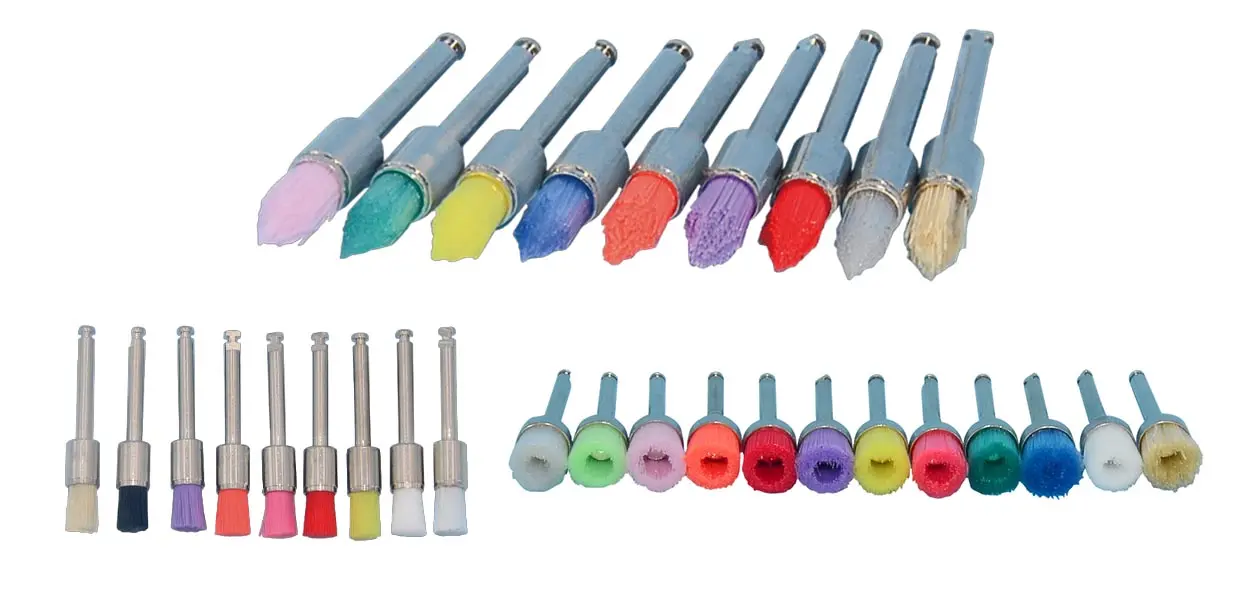
Application scenarios:
- Nylon soft-bristle prophy brushes are flexible and wear-resistant, suitable for polishing most tooth surfaces. They can be used for teeth whitening and mouth cleaning.
- Nylon hard-bristle prophy brushes are harder and are commonly used to remove stubborn tartar or stains. They can be used with various polishing pastes to polish restorations or to grind off excess adhesives and resin-filled materials.
- Animal bristle prophy brushes have good biocompatibility and high flexibility, but their wear resistance is not as good as synthetic fiber brushes. They can be used for tooth surface polishing or for grinding and polishing brittle restorations such as porcelain crowns.
Dental prophy brushes are mainly used for polishing areas such as interdental spaces and pits and fissures. Thanks to its various types of brush heads, it can reach areas that are difficult to access with a regular toothbrush. For example, after orthodontic treatment, a conical prophy brush can be used to remove residual adhesive around brackets.
Operational tips:
When cleaning teeth with a soft-bristle prophy brush, toothpaste can be used for more thorough cleaning. However, when polishing and grinding excess adhesive, polishing paste must be used. Rotate at low speed and gently contact the tooth surface to avoid excessive pressure that could damage the enamel. If the tooth brightness is insufficient, a prophy cup can be used in combination. The rubber’s flexible wrapping properties allow for more precise polishing, resulting in a bright and white tooth surface. After completing the polishing procedure, rinse your mouth with water to remove debris and residual polishing paste generated during the process.
2. Dental Prophy Cup
The prophy cup consists of a metal base and a rubber head. The rubber has excellent elasticity and flexibility. The outer edge of the prophy cup has a certain curvature, allowing it to conform well to the tooth surface. This makes the prophy cup have stronger wrapping when polishing the tooth surface, increases the friction area, and enables more precise polishing. The rubber head of the dental prophy cup is available in two types: flat and granular with adhesive points.
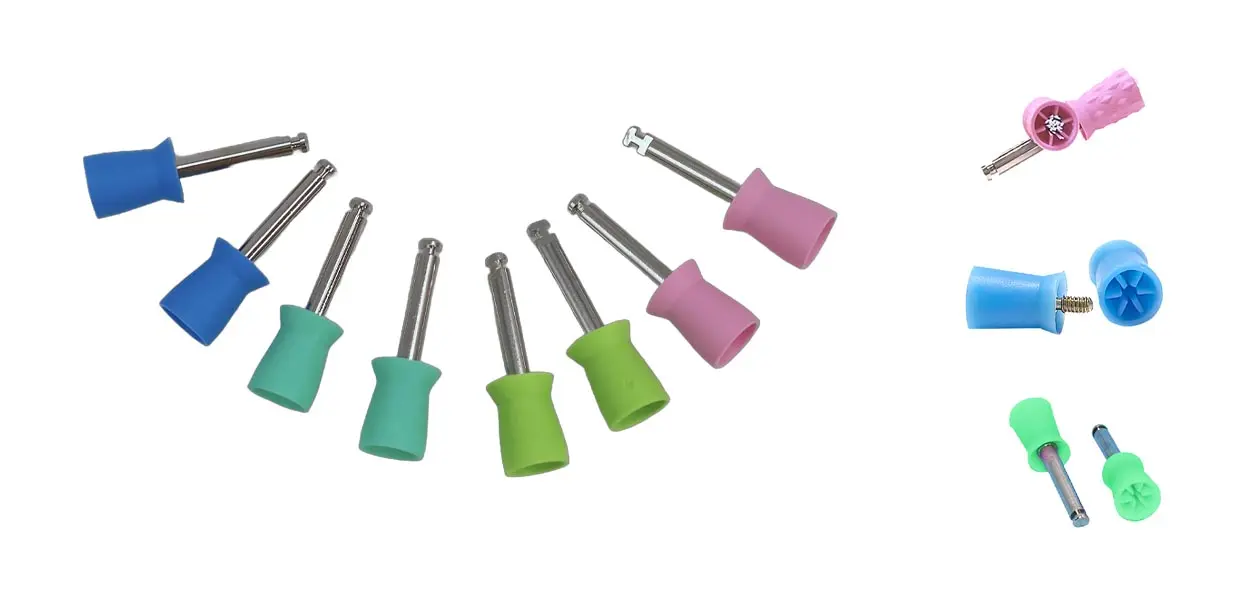
Application scenarios:
Flat-type prophy cups are suitable for polishing natural teeth and metal restorations. They are widely used for polishing large, flat areas such as anterior and posterior teeth. Particulate-surface prophy cups, in combination with fine-grained polishing paste, can polish restorations to achieve seamless integration with natural teeth, enhancing aesthetic appeal. The rubber material of the prophy cup causes minimal damage to restorations made of resin or ceramic, making it ideal for post-restoration polishing.
For example, after resin filling, first use a prophy brush to remove residual adhesive and excess resin material from the tooth surface. Then use the prophy cup to carefully polish the filling contact surface, removing the tiny scratches left on the resin tooth from the previous step until the resin and the natural tooth are perfectly integrated. This not only enhances the aesthetic appeal of the teeth but also maintains the smoothness of the tooth surface, reducing bacterial adhesion.
Operational tips:
After installing the prophy cup on a low-speed handpiece, adjust the angle between the prophy cup opening and the tooth surface periodically to ensure even contact. When polishing, move in a circular motion with moderate pressure to avoid overheating the tooth surface or excessive wear on the restoration due to localized friction.
3. Polishing discs
Polishing discsare thin sheet polishing tools, with a thickness typically ranging from 0.1 to 0.3 millimeters. They are mostly made of polyester fiber, aluminum oxide, or silicon carbide, with abrasive particles of varying grit sizes (divided into multiple grades from coarse to fine) attached to their surfaces. They can be secured to a dental handpiece using dedicated tray or clamp.
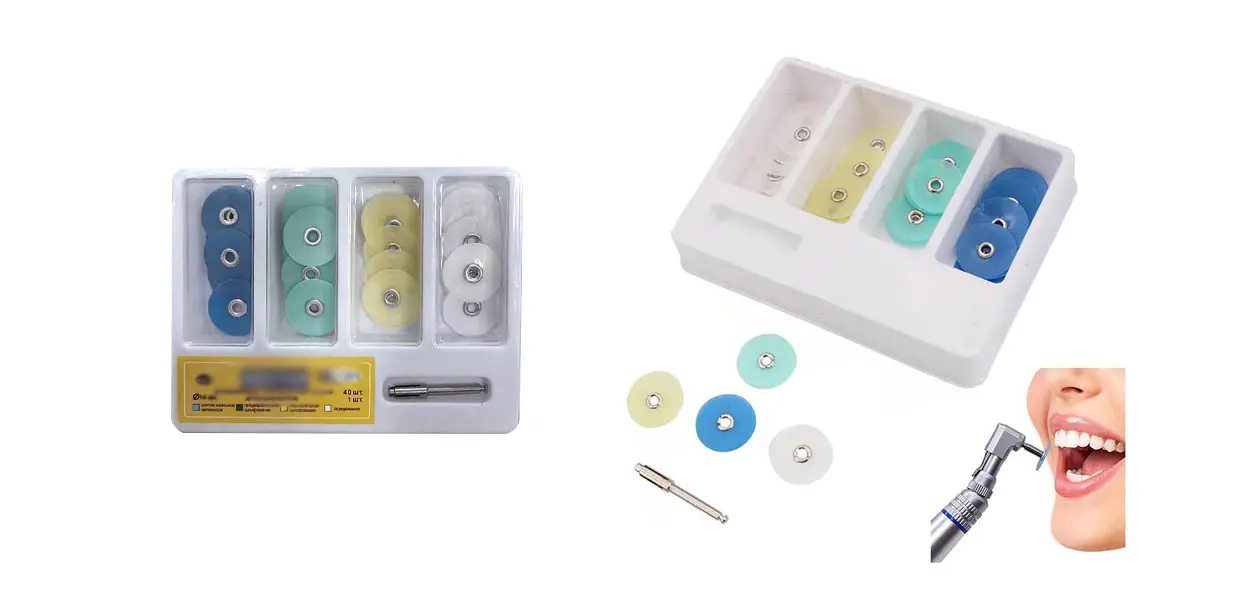
Materials and Characteristics:
Polyester fiber-based polishing discs have good flexibility and are suitable for adhering to the adjacent surfaces and edges of teeth. Alumina abrasive has uniform particle size and high polishing efficiency, and is often used for initial rough polishing. Silicon carbide abrasives have high hardness and strong fineness, making them suitable for final mirror polishing.
Applicable scenarios:
It is mainly used for polishing the edges of tooth crowns and large areas of tooth surfaces. Especially suitable for post-restoration polishing of porcelain crowns and resin tooth structures. Fine-grained polishing discs can also be used to trim the junction between the crown edge and the gums to avoid irritating the gum tissue and reduce plaque accumulation at the same time. Due to the large structural surface of the polishing disc, it is not suitable for polishing delicate gaps between teeth or hard-to-reach areas. In such cases, a conical-headed polishing brush can be used for assisted polishing.
Operational points:
The appropriate grit size of the polishing disc should be selected according to the polishing stage, progressing from coarse to fine. It can also be used in combination with a prophy cup for the final fine polishing. When using, keep the disc parallel to the tooth surface and gently contact the edge areas to avoid disc breakage or gum damage due to excessive force.
4. Dental Polishing strips
Dental polishing strips are long, flexible tools with a width of usually 4 millimeters and a length of 6 meters per roll. They are made of resin or nylon, and their surfaces are treated with a special sand-planting process to attach abrasives (such as alumina particles). The abrasives are firmly bonded and do not shed, and the base material is thin, highly flexible, and does not deform when pulled. Some products also contain soothing ingredients like mint.
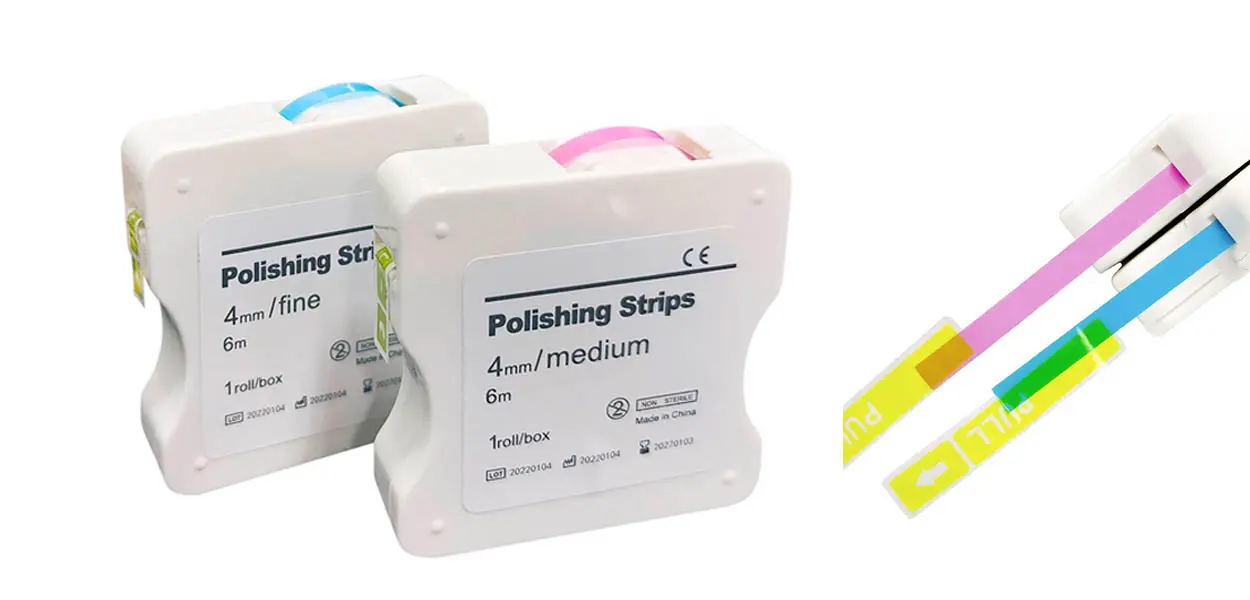
Materials and Characteristics:
Resin polishing strips are easy to plant sand and can adsorb more polishing abrasives. Different types of polishing strips can be implanted with abrasives of different particle sizes. From coarse polishing to fine polishing. Nylon cloth polishing strips are highly flexible and resistant to fraying, making them ideal for medium-grit polishing.
Application Scenarios:
It is specifically designed for polishing the interproximal surfaces of teeth, especially in areas with narrow interdental Spaces that other polishing tools cannot reach. For example, after teeth cleaning, polishing strips can remove residual tartar fragments and stains from tooth surfaces, preventing interproximal caries. In orthodontic treatment, they can clean plaque between brackets, reduce plaque proliferation, and prevent enamel demineralization risks.
Operational Guidelines:
Gently insert the polishing strip into the interdental space and move it slowly in a “sawing” motion to ensure contact with the entire interproximal surface. For sensitive gum areas, apply a gum protectant first to prevent bleeding caused by friction from the polishing agent.
5. Polishing grinding head
A polishing grinding head is a grinding and polishing tool. Its main function focuses on trimming the edges of dental filling materials or removing burrs at the interface of dental crowns. The material of its head is rubber or resin, and its shapes include spherical, conical, cylindrical, etc. The base is made of stainless steel and is used to connect dental handpiece, compatible with both high-speed and low-speed handpieces. The surface of the polishing grinding head is coated with abrasive materials (such as diamond or silicon carbide) through sintering or bonding techniques.
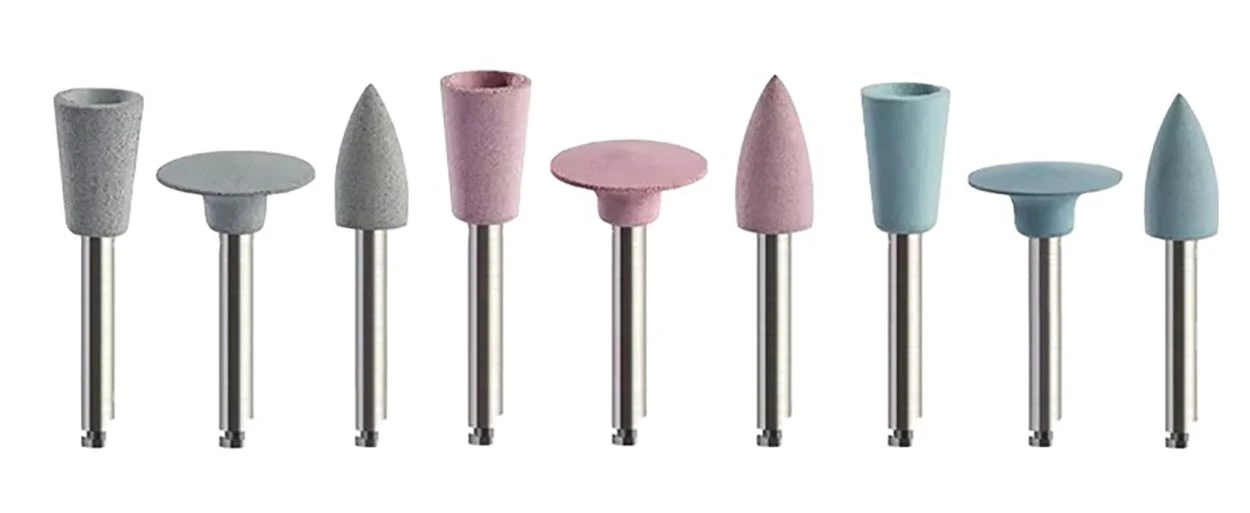
Material and Characteristics:
- Resin polishing grinding head: It has a relatively high hardness and is suitable for rough grinding and shape shaping of metal restorations, or fine polishing of porcelain-fused-to-metal crowns.
- Rubber polishing grinding head: It has good elasticity, similar to a polishing cup, and is suitable for fine polishing of natural teeth, especially for restoring the luster of teeth after whitening.
Applicable scenarios:
Polishing grinding heads are used in multiple stages from shape correction, rough grinding to fine polishing. For instance, after the implant abutment is installed, the burrs on the edge of the abutment are trimmed with a polishing grinding head. Trim and roughly grind the filling resin material, and then finely polish it with a rubber grinding head to restore its brightness and whiteness. After teeth whitening, use a rubber fine-grained grinding head in combination with whitening polishing paste to further enhance the luster of the tooth surface.
Operational Points:
- For grinding heads used in conjunction with high-speed handpiece, the rotational speed should be controlled (usually no more than 20,000 revolutions per minute) to prevent damage to the dental pulp due to overheating.
- Low-speed grinding heads need to be combined with appropriate pressure to ensure that the abrasive fully contacts the tooth surface and achieves the ideal polishing effect.
Conclusion
There are various types of dental polishing tools, but their core goal remains the same – to enhance the beauty and smoothness of teeth or restorations through precise and safe operation. In clinical applications, doctors need to flexibly select appropriate tools and polishing agents based on different treatment requirements (such as postoperative trimming, daily care or whitening), the material of the restoration (such as resin, ceramic, metal), and the location of the tooth in order to achieve the best polishing effect.
Moderate tooth polishing not only restores the smoothness of teeth and reduces the adhesion of dental plaque, but also plays a certain protective role in preventing tooth decay to a certain extent. However, excessive polishing may damage the enamel and lead to dental health problems.


